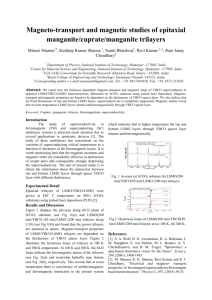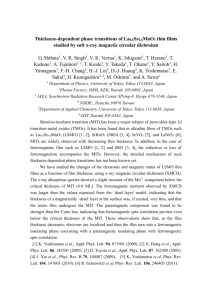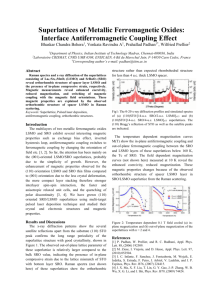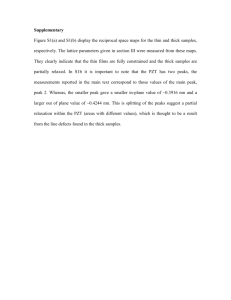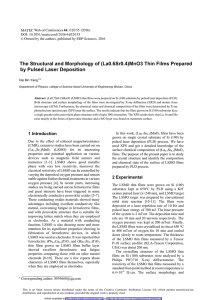Strain Tuning of Transport and Magnetism of La Sr MnO
advertisement
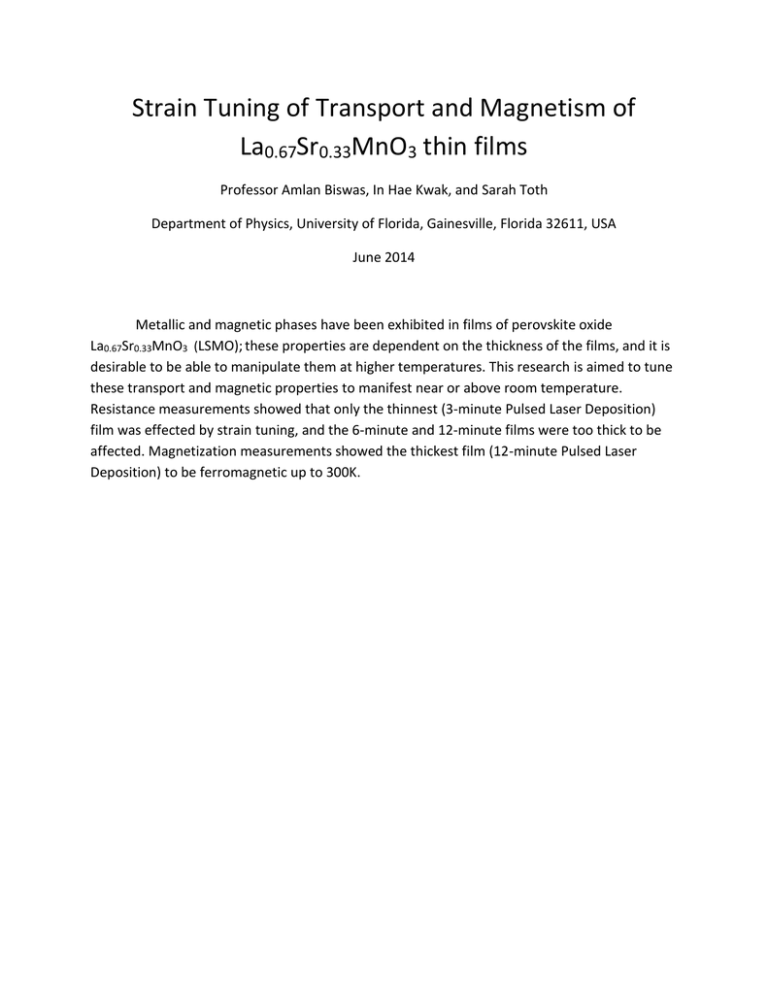
Strain Tuning of Transport and Magnetism of La0.67Sr0.33MnO3 thin films Professor Amlan Biswas, In Hae Kwak, and Sarah Toth Department of Physics, University of Florida, Gainesville, Florida 32611, USA June 2014 Metallic and magnetic phases have been exhibited in films of perovskite oxide La0.67Sr0.33MnO3 (LSMO); these properties are dependent on the thickness of the films, and it is desirable to be able to manipulate them at higher temperatures. This research is aimed to tune these transport and magnetic properties to manifest near or above room temperature. Resistance measurements showed that only the thinnest (3-minute Pulsed Laser Deposition) film was effected by strain tuning, and the 6-minute and 12-minute films were too thick to be affected. Magnetization measurements showed the thickest film (12-minute Pulsed Laser Deposition) to be ferromagnetic up to 300K. I. Introduction Interesting magnetic behavior is observed in thin films of La0.67Sr0.33MnO3 (LSMO); these include the coupling of electric and magnetic properties, two properties which are usually mutually exclusive1. Research into similar perovskite oxide (La0.4Pr0.6)0.67Ca0.33MnO3 (LPCMO) has shown success in exhibiting ferromagnetic metallic (FMM) and charge-ordered insulating (COI) phases simultaneously, albeit only at low temperatures. We now seek to find this in thin films of LSMO at room temperatures. Bulk LSMO is ferromagnetic and metallic2. Using thin film strain we seek to manipulate the transitions to manifest at higher temperatures (room temperature). Significant differences from bulk behavior have been observed with decreasing thickness: at high temperatures from a ferromagnetic metal to a paramagnetic insulator, and at low temperatures from a ferromagnetic metal to a ferromagnetic insulator3. These transitions, if manifested at higher temperatures, could optimize the manufacturing process of this compound (used in electronic applications), possibly reducing costs and increasing efficiency of data storage devices. This research aims to tune the electronic transport and magnetic properties of LSMO to attain phase transitions and/or phase separation at higher temperatures possibly near or above room temperature. II. Experimental Details a. All LSMO samples were grown on atomically smooth SrTiO3 (STO) substrates. Approximations of atomically smooth surface of LSMO was achieved through the following cleaning, acid etching, and thermal annealing procedure4: i. Cleaning the sample: 5 minute agitation in sonicator (make/model: Branson 1510) with acetone; then 5 minute agitation in sonicator with ethanol; blow-dry with N2 gas. ii. Acid etching: 30 min deionized water (DIW) sonication in sonicator bath at 55°C, followed immediately by 12 min sonicaton in Aqua Regia (3HCl+HNO3) and then 30 second rinse with DIW. iii. Clean with acetone and ethanol again (following previous cleaning procedure). iv. Thermal Annealing: Place sample on ceramic boat in center of tube furnace (Thermolyne Type 21100 Tube Furnace). Ramp up in temperature following the following timetable: Heating Cooling % time on Duration Final temp (°C) % time on Duration Final temp (°C) 4 35 550 3 10 860 6.2 35 900 1.5 15 650 Hi 3 1000 Lo 10 550 6.2 off Figure 1. Heating and cooling ramp rates on Thermolyne Tube Furnace. During the final heating stage, hold the temperature between minimum 1000°C and maximum 1050°C for 30 minutes. Then begin cooling. Allow to cool completely back to room temperature before attempting to handle or continue. v. Clean the sample following the cleaning procedures as before. b. Smoothness of the sample surface was imaged using Contact Mode atomic force microscopy on a Digital Instruments Scanning Probe Microscope. Multiple locations on the sample are imaged at 5x5 and 2x2 µm2 in order to ensure quality surface terraces. c. Thin films of LSMO are then grown on STO substrate using Pulsed Laser Deposition for the allotted duration for each sample: 12-minute deposition (approx. 31 unit cells thick), 6- minute deposition (approx. 15 u.c. thick), and 3-minute deposition (approx. 8 u.c. thick). The laser (Lambda Physik Lextra Excimer) was set to λ=248 nm, KrF. This was carried out at a substrate temperature of 780°C, O2 pressure at 65-70 mTorr, and laser energy of 420 mJ. d. After thin film deposition, the sample is cleaned of silver paint around edges using fine sandpaper. Electrical contacts are placed at each of the four corners of the sample using indium sodder and gold wiring. e. Finally, the sample is mounted on the resistivity probe, and lowered into a Helium cryostat for measurement of its resistance vs temperature. i. Note: Initially wiring is such that current runs across (perpendicular to) the atomic steps of the surface, and then once the measurement is finished, re-wired to measure the effect of current running along (parallel to) the atomic steps. (only the current direction is changed). f. Resistivity is measured from 20K to 350K (warming run) and back from 350K to 20K (cooling run) for both directions. III. Magnetization was measured only for the 12-minute sample in a Superconducting Quantum Interference Detector (SQuID). (a) (b) Figure 2: STO substrate (a) and 12-minute LSMO surface (b). 5x5 µm2. Steps are slightly angled but clean. (c) (d) Figure 3: STO substrate (c) and 6-minute LSMO surface (d). 5x5 µm2. Steps are slightly angled, wavy, and wide. (e) (f) Figure 4: STO substrate (e) and 3-minute LSMO surface (f). 5x5 µm2. Steps are vertical and exhibit wavy, protruding edges. IV. Results and discussion The quality of epitaxial LSMO thin films is highly dependent on the substrate having a high quality (atomically smooth) substrate surface4. STO was prepared such that the process accentuated and cleaned the existing atomic steps that arise from the manufacturing cut, generating uniform atomic steps. STO substrate surfaces looked even with few islands (areas of uneven unit cell height). 12-, 6-, and 3-minute LSMO film surfaces looked smooth as well (Fig. 2, 3, 4). Resistance-temperature measurements show high resistance (~440Ω) at high temperatures (~350K) in both directions (across and along the atomic steps); this was converted to resistivity values for the material using the van der Pauw method (Fig. 5), in order to control for variations in shape of samples5. However, upon inspection the resistivity trend between the films was irregular. So, the van der Pauw method was checked using a linear conversion method in order to better explain the irregularities. Additionally, the 12-minute and 3-minute samples show an unexplained anisotropy between 100K and 250K. EHFG EFGH EHFG EFGH 600 0.005 0.004 Resistivity (cm) Resistance () 400 200 0.003 0.002 0.001 0 0.000 0 100 200 300 0 400 50 100 150 200 250 300 350 400 Temperature (K) Temperature (K) Figure 5: Resistance vs. temperature graph (left) and resistivity vs. temperature graph (right) for 12-min LSMO. EHFG denotes current along steps (parallel), and EFGH denotes current across steps (perpendicular). EFGH EHFG Figure 6: Resistivity for 6-min LSMO. EFGH denotes current along steps (parallel), and EHFG denotes current across steps (perpendicular). Resistivity (cm) 0.002 0.001 0.000 0 100 200 Temperature (K) 300 400 EFGH EHFG 0.010 Resistivity (cm) 0.008 Figure 7: Resistivity for 3-min LSMO. EFGH denotes current along steps (parallel), and EHFG denotes current across steps (perpendicular). 0.006 0.004 0.002 0.000 0 100 200 300 400 Temperature (K) 3 min 6 min 12 min 0.010 Corrected Resistivity (cm) Resistivity (cm) 0.008 0.006 0.004 0.002 3 min 6 min 12 min 0.02 0.01 0.00 0.000 0 100 200 Temperature (K) 300 400 0 100 200 300 400 Temperature (K) (a) (b) Figure 8: Resistivities for all three films. Van der Pauw method (a), and corrected linear method (b). In addition to resistance measurements, for the 12-minute film only (due to the unavailability of the SQuID), the magnetization was measured at four different temperatures in both directions (parallel and perpendicular to atomic steps). Due to the visible hysteresis in the magnetization (Fig. 9), it can be seen that this LSMO film is ferromagnetic at all temperatures up to 300K. 10K 20K 250K 300K 10K 20K 250K 300K 0.0002 Long Moment (emu) Long Moment (emu) 0.0002 0.0000 -0.0002 0.0000 -0.0002 -1000 0 1000 Field (Oe) -1000 0 1000 Field (Oe) Figure 9: CMR for 12-minute LSMO at 10, 20, 250, and 300 K. Parallel direction (left), perpendicular direction (right). V. Conclusion In regards to electron transport in LSMO, our research shows highest resistivity in the 15 u.c., 3-minute (thinnest) LSMO film. This is in accord with the finding that the thinner the film, the more affected it is by substrate strain. However, although the 31 u.c. (6-minute) and 62 u.c. (12-minute) films both exhibit lower resistivity than the 15 u.c. film, they do not seem to continue to be affected by substrate strain in the same way; rather, it is more likely that they are exhibiting bulk behavior. It seems that at some point around 15 u.c. in thickness, LSMO films exhibit this bulk behavior and become resistant to strain. In regards to the magnetic properties of LSMO, the 62 u.c. film is ferromagnetic, as seen from the observed hysteresis in magnetization data. Additionally, the data is very similar in both the parallel and perpendicular directions, indicating no magnetic anisotropy. In order to have a more complete picture of how the magnetic properties vary with thickness, it would be necessary to also perform magnetization tests on the 6-minute and 3minute film. This will hopefully be accomplished in the future, as the SQuID becomes more readily available for use. 1. S.-W. Cheong and M. Mostovoy, Nat. Mater. 6, 13 (2007). 2. Sayani Majumdar and Sebastiaan van Dijken J. Phys. D: Appl. Phys. 47 (2014) 3. Electric field driven dynamic percolation in electronically phase separated (La0.4Pr0.6)0.67Ca0.33MnO3 thin films, Hyoungjeen Jeen and Amlan Biswas, Phys. Rev. B 88, 024415 (2013) 4. Kareev, Alexander, Venu Kodupaka, Mikhail Kareev, and Jak Chakhalian. "Novel Method of Preparation and Imaging of Atomically Flat Surfaces of SrTiO3" University of Arkansas (n.d.): n. pag. 5. van der Pauw, L.J. (1958). "A method of measuring specific resistivity and Hall effect of discs of arbitrary shape" Philips Research Reports 13: 1–9.
